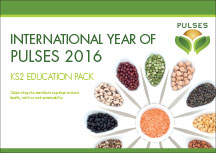Lesson Plans

This pack contains six, hour-long lesson plans designed to appeal to children aged 8-11 years old. There are many ways of using the IYP theme to enhance the school curriculum and these resources contain information, facts and figures together with ideas and activities that will bring issues such as health and nutrition, food security and environmental sustainability into your classroom. The plans are designed to either build concurrently or work as stand-alone classroom activities.
The aim is to inspire young people – not only to think about the role of pulses (grain legumes) in feeding the world, but to motivate them into playing a more active role in matters affecting their environment. We hope that your students enjoy the activities in this pack.